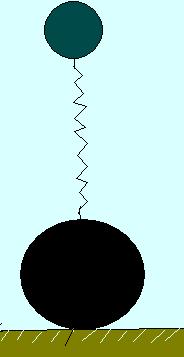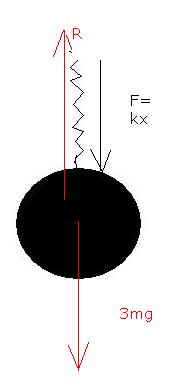Post 13 is the question ....try it out...it's a good one !

smaller ball mass = m ; larger mass = 3m ; spring constant =k;
smaller mass pressed down by a distance δ.
Then comes my doubt :
which one is right :
1) N (normal reacn.) = mg + 3mg + kδ
2) N = mg + 3mg - kδ
My explanation : Ans. is (2) as tensile force of kδ acts opposite to the direction of mg and 3mg. Am i right ? If i'm not , pls rectify me.....
-
UP 0 DOWN 0 0 22

22 Answers
kk dude i am there
first i am assuming h=0 at the psition when the spring is unstretched now let us compress the spring by distance x
therefroe since the springs already compressed by a distance mg/k
the total compression is mg/k+x
and oss in p.e of the masss is mgx
that is my first line after this the total mechanichal enrgy of the system remains constant as no external force is acting on the masss
any more doubts pls post it on my chat box
@Varun.Tinkle....can u plzzz explain ur soln .. ??? This part : line 5 of your soln. :
1/2k(mg/k +x)^2-mg(x+mg/k)= E1
kkkk i think its upto me!!
isystem enrgy is conserved at all pnts so........
assuming for p.e x=0 at the unstretched position not equillibriu position
fine
now 1/2k(mg/k +x)^2-mg(x+mg/k)= E1
when mass m2 is abt to break force acting on it will be 3mg so x will be 3mg/k...
so at this time ... enrgy is
1/2k(3mg/k)^2+mg(3mg/k)
=7.5 (mgk whatever)
now
1/2k(mg/k +x)^2-mg(x+mg/k)>7.5
doing hit and trial we get x as 4mg/k first part done
now sfor N first since it is compressed by a distance 2mg/k total compression is mg/k+2mg/k =3mg/k so force acting is 3mg
since it is in equilibrium N=3mg+3mg
=6mg(this sum is from dc pandey)
yes , i had made that small mistake !! sorry !!
nishant had drawn the correct FBD !
Aveek .. I solved it in the class... (dont know if u were/ are attending) Read what organic has written.. I think you are not clear about how to draw the fbd!
@organic you have made a very small mistake... as pointed by qwerty.. (but what you are saying is absolutely correct)
i think organic has made a mistake in giving sign of kx and nishant sir is right .......
see look at this in the following manner ......
when the small mass is pressed down ....the spring is compressed ........
now the force kx arises ....but y does it arise?????
of course to remove the compression
so the spring will push both the masses away frm the spring ......
@ organic according to ur sign ........ spring is trying to compress more ..wich i think cant be the case .....
And another clue ............... it's a question with more than one answer correct... :-)
sorry dude.........it's not the right answer...
The question is that the upper disc is at first on the top with the spring absolutely relaxed and then it's pressed down by a distance δ. Now try !!!
net force acting whwn particle is going up ......
(kx-mg)
work energy thorem.....
Fext.dx=delta k.e
.5k *d^2 -mgd=k.e.........
at topmost pont k.e =0..........(let it go d' above the eq position)
net force acting after going above equilibrium is -(kx+mg)....agin apply work energy..
and equate both eq .....
k(d-d')=mg........
making normal> 0 for lower one......
kd'>3mg and put in the above eq........
d>4mg/k
neone trying out ?.......hint bouncing off means normal reaction = 0
Okie i'm posting the actual quest.
After pressing the smaller mass down it's released. Then select correct statement :
A) if δ>3mg/k the lower disc will bounce up
B) if δ=2mg/k maximum normal reaction from ground on lower disc
=6mg
C) if δ=2mg/k maximum normal reaction from ground on lower disc =
4mg
D) if δ>4mg/k lower disc will bounce up
look ,,,you are confused with the systems....you are considering the systems vaguely !
arre yaar soch ke dekh .....if u press down upon a spring u feel a pressure on ur hand....
now come to a quantitative view....why is the larger mass feeling a weight.....Normal reacn. shld balance the next ext. F.
wt. of smaller mass mg presses down upon the spring connected to the larger mass and spring force is also acting on the larger mass.....now see for urself
where do you get (mg) as an external force???? what kind of vague methods are u using??
The net external forces on the Larger mass will be balanced my Normal Force...isn't it ? But I'm perfectly sure about my method....as it has given the answer which matches with that of the book...
dear...mg is the force of attraction of earth on smaller mass !! the reaction force for this is given by the smaller mass to the earth...what has it to do with the larger mass ????
@Nishant Sir and organic............i think there will be an extra force mg acting on the larger block due to the smaller one .
If the larger ball is placed on the ground,
drwaw the fbd..

now say?